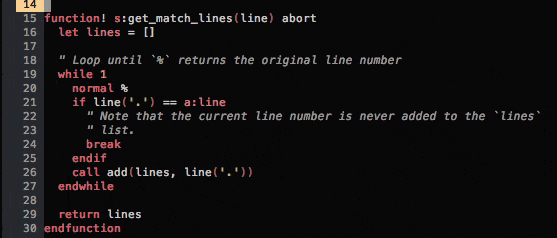Atualmente, o Vim destaca parênteses, parênteses, aspas, etc. com fundo ciano e primeiro plano branco - o cursor pode ser movido entre eles com %. Graças ao meu matchit.vim, também posso alternar %entre if / end, for / end, etc. - no entanto, eles não são destacados na seleção.
Como destacar automaticamente esses pares correspondentes na seleção, como é feito automaticamente entre parênteses?
Além disso, como posso modificar a cor de fundo usada para esses pares usando :highlight?
Desde já, obrigado.
Atualizei a resposta de @ Tommy A abaixo para dar conta de matchit.vimgrupos mal especificados e outras situações em que o %operador nunca retorna o cursor para a posição original. Confira as diferenças no loop "while". Qualquer pessoa que esteja lendo este tópico é aconselhada a usar esta versão, para evitar loops infinitos:
function! s:get_match_lines(line) abort
" Loop until `%` returns the original line number; abort if
" (1) the % operator keeps us on the same line, or
" (2) the % operator doesn't return us to the same line after some nubmer of jumps
let a:tolerance=25
let a:badbreak=1
let a:linebefore=-1
let lines = []
while a:tolerance && a:linebefore != line('.')
let a:linebefore=line('.')
let a:tolerance-=1
normal %
if line('.') == a:line
" Note that the current line number is never added to the `lines`
" list. a:line is the input argument 'line'; a is the FUNCTION BUFFER
let a:badbreak=0
break
endif
call add(lines, line('.'))
endwhile
"Return to original line no matter what, return list of lines to highlight
execute "normal ".a:line."gg"
if a:badbreak==1
return []
else
return lines
endif
endfunction
function! s:hl_matching_lines() abort
" `b:hl_last_line` prevents running the script again while the cursor is
" moved on the same line. Otherwise, the cursor won't move if the current
" line has matching pairs of something.
if exists('b:hl_last_line') && b:hl_last_line == line('.')
return
endif
let b:hl_last_line = line('.')
" Save the window's state.
let view = winsaveview()
" Delete a previous match highlight. `12345` is used for the match ID.
" It can be anything as long as it's unique.
silent! call matchdelete(12345)
" Try to get matching lines from the current cursor position.
let lines = s:get_match_lines(view.lnum)
if empty(lines)
" It's possible that the line has another matching line, but can't be
" matched at the current column. Move the cursor to column 1 to try
" one more time.
call cursor(view.lnum, 1)
let lines = s:get_match_lines(view.lnum)
endif
if len(lines)
" Since the current line is not in the `lines` list, only the other
" lines are highlighted. If you want to highlight the current line as
" well:
" call add(lines, view.lnum)
if exists('*matchaddpos')
" If matchaddpos() is availble, use it to highlight the lines since it's
" faster than using a pattern in matchadd().
call matchaddpos('MatchLine', lines, 0, 12345)
else
" Highlight the matching lines using the \%l atom. The `MatchLine`
" highlight group is used.
call matchadd('MatchLine', join(map(lines, '''\%''.v:val.''l'''), '\|'), 0, 12345)
endif
endif
" Restore the window's state.
call winrestview(view)
endfunction
function! s:hl_matching_lines_clear() abort
silent! call matchdelete(12345)
unlet! b:hl_last_line
endfunction
" The highlight group that's used for highlighting matched lines. By
" default, it will be the same as the `MatchParen` group.
highlight default link MatchLine MatchParen
augroup matching_lines
autocmd!
" Highlight lines as the cursor moves.
autocmd CursorMoved * call s:hl_matching_lines()
" Remove the highlight while in insert mode.
autocmd InsertEnter * call s:hl_matching_lines_clear()
" Remove the highlight after TextChanged.
autocmd TextChanged,TextChangedI * call s:hl_matching_lines_clear()
augroup END
